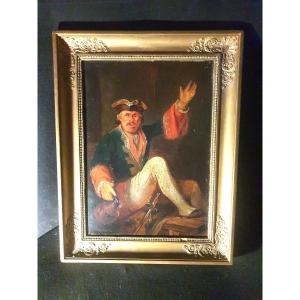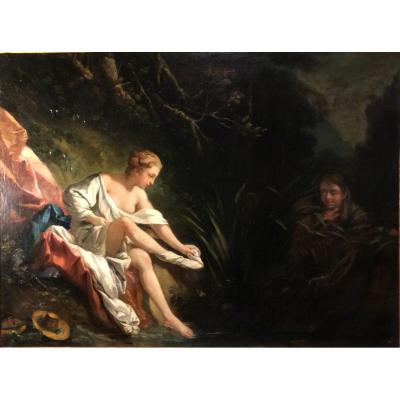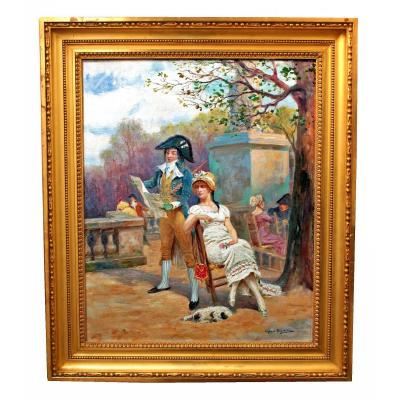Eugène Modeste Edmond Poittevin was born in Paris in 1806, at 8 rue de Ventadour in his family home. His father, Nicolas Jean Baptiste Modeste Poidevin, originally from Rouen, was a cabinetmaker and later the chief cabinetmaker at the Château de Versailles, where the family moved. An average student but an artist at heart, Eugène became a pupil of a local painter named Ledoux. At 15, to prove his artistic vocation against his father's wishes, he made a copy of the painting *Le Sac de la Ville* by Nicolas Antoine Taunay at the Château de Versailles. This copy caused a sensation in Versailles, leading the Duchess of Berry to grant him a pension of 500 francs from King Louis XVIII's funds. He briefly attended the studio of Xavier Leprince, whose career was short, with only around twenty paintings exhibited in the Salons of 1819, 1822, and 1824. Nevertheless, Poittevin borrowed Leprince's taste for anecdotal and picturesque scenes. Under Leprince's influence, Eugène traveled to Normandy, Brittany, the Landes, Italy, Belgium, the Netherlands, Germany, and England (London).
In 1826, after Leprince's death, Poittevin was admitted to the École des Beaux-Arts in Paris, in the studio of Louis Hersent, who also trained Karl Girardet and Augustin Pajou. He unsuccessfully attempted the Grand Prix de Rome twice.
After Leprince's death, he took over his studio and exhibited three works at the Salon under the name Potdevin, achieving success.
His father changed his name to Le Poittevin and was appointed to the Château des Rohan near Strasbourg. In 1829, Eugène Le Poittevin won second prize in the Grand Prix de Rome competition, deemed too young for the first prize. His teacher Hersent encouraged him to work from nature. He exhibited successfully at the Salons from 1831 until his death in 1870.
### Early Salon Exhibitions
Following Leprince's premature death in December 1826, Poittevin completed one of the major compositions he had planned for the 1827 Salon: a view of his studio that he had begun the previous year. He finished this painting by executing 11 of the 36 portraits included in the composition. The painting was presented at the 1827 Salon under the title *Intérieur de l'atelier de feu Leprince*, with Poittevin identified as Eugène Potdevin. This marked Poittevin's first participation at the Salon. He also presented three works: *Des Moissonneurs* (acquired by the Duchess of Berry for her gallery), *Une porte de ferme*, and *Vue prise entre Saint-Germain et Versailles*. The latter was purchased by collector Du Sommerard, who also acquired *Intérieur de l'atelier de feu Leprince* finished by Poittevin.
His second exhibition at the 1831 Salon marked a significant breakthrough. He presented nine paintings, this time under the name Lepoittevin, featuring picturesque landscapes populated with figures, climatic views, rural motifs, and marine scenes. Many titles revealed the precise locations depicted, such as *Moulin anglais situé sur le bord de la mer*, *Intérieur de cour, pris en Normandie*, and *Un sloop échoué, vue prise sur les côtes d'Angleterre, à la marée basse*. His marine painting *Vue prise aux Bords de la Tamise* earned him a second-class medal. He continued to shine in subsequent Salons, receiving honorable mentions in 1833 and 1834, and a first-class medal in 1836 for another marine, *Pêcheurs normands*.
From 1836, he began exhibiting at the Salon of Brussels; that year, he presented three works: *Sauvetage de débris*, *Scène de pêcheurs normands, à marée basse*, and *Défense d'une cote*. He was awarded a silver medal at this Salon. This recognition led him to focus more on Belgium, as noted in the 1837 Salon of Bruges, where he was listed as residing in Brussels. Interestingly, he also appeared in the French press as a member of the Academy of Fine Arts in Brussels.
In France, official recognition came swiftly; it peaked at the Salon of 1843 when he received the Legion of Honor at the age of 37.
### Caricatures of 1830
He provided lithographic plates for Charles Philipon's journal *La Caricature* and initiated the trend of lithographic caricatures, like *Le Diable fecit* and *Diabolico Foutromanie* (a collection of 12 plates), which featured humorous and often risqué scenes. These works were quickly censored and condemned to destruction in 1845 for moral offenses.
### Commissions for Versailles
In 1834, the Louis-Philippe government commissioned him to create *Combat de Wertingen du 8 octobre 1805* for the historic museum at Versailles, followed by *Bataille navale remportée devant l'île d'Embro, 1346* in 1835. His work *L'Attaque des ours blancs* was purchased by the state and displayed at the Musée du Luxembourg. After traveling to Algeria in 1840, he returned ill but exhibited works such as *Gueux de mer* and *Soleil couchant* at the Rouen Salon. He received further commissions for the historic museum at Versailles, including *La Prise de Baruth le 17 mai 1109* and *Déjeuner offert à la reine Victoria sous la tente au mont d'Orléans*.
### Success in Prussia and Belgium
He traveled and exhibited regularly in Berlin starting in 1839, then in Belgium. By 1841, he was exhibiting in Leipzig and Dresden. He was promoted by Prussian art dealer Louis Sachse, a pioneer in the art market. His classes attracted many German students in Paris, and he became a member of the academies of Antwerp and Berlin.
He was appointed Knight of the Legion of Honor in Paris in 1843 and Knight of the Order of Leopold in Brussels in 1845. He married Stéphanie Maillard in 1846, with whom he had a daughter, Eugènie. The name change to Le Poittevin was formalized then. His second daughter, Marie, was born in 1847. In 1848, he was part of a committee to organize and safeguard the interests of art and artists.
In 1849, he was named official painter of the Marine.
### Genre Scenes
His wife died in 1851, and he built a villa, La Chaufferette, in Étretat, along with a studio by the seaside where he frequently stayed. The themes of the sea, fishermen, and their families, with whom he developed friendly relationships, became central in his work. He painted scenes of seaside bathing and exhibited works such as *Les Bains de Mer à Étretat*. At the 1867 Exposition Universelle in Paris, he showcased *Bains de Mer, plage d'Étretat*, which was acquired by Napoleon III for the Élysée Palace. His *Naufrage dans les mers polaires* was presented at the 1869 maritime exhibition in Le Havre.
That same year, he lent his Étretat studio to Gustave Courbet, who painted his famous *Falaise d'aval après la pluie* and the series *La Vague* there.
Simultaneously, Poittevin, known for his humor, created whimsical pieces like *Cendrillons* and *Petit Chaperon rouge*, which caricatured friends of the artist watching a Norman woman bathe.
In 1870, despite being gravely ill, he presented his final painting at the Salon, *Vue des environs d'Étretat pendant la saison des bains*. He died at his daughter Eugénie's home on August 6, 1870. His second wife, Adèle Pironin, whom he married in 1861, passed away in 1872.
The collection from Poittevin's studio, which included 144 paintings and thousands of drawings, was sold at the Drouot auction house in Paris from April 9 to 12, 1872.
### Style
His genre scenes were inspired by Eugène Isabey, who introduced him to Étretat, and by Dutch painting, which he studied during a stay in the Netherlands. He regularly collaborated with friends like Hippolyte Bellangé and Émile-Henri Brunner-Lacoste.
His preference for realism connected him to the young school of the 1830s while he remained true to the romantic style of his early years as a historical painter for Versailles, close to Léon Cogniet.
Critic Charles-Paul Landon described Poittevin as an uneven painter of great talent whose Salon works varied significantly in quality, advising him to be cautious. In 1839, *Journal des artistes* noted Poittevin's facility with talent, which he often overused, presenting 12 to 15 paintings at the Salon each year. At the 1848 Salon, his work *David Teniers conduisant Don Juan D'Autriche* was met with severe criticism from Louis Van Roy for its drawing and perceived false colors, despite noting its elegance and distinction.
### The Hôtel Blanquet in Étretat
A precursor, alongside Eugène Isabey, to the many landscape painters who frequented Étretat in the 19th century, Eugène Lepoittevin was also the creator of the famous sign painted in 1842 that adorned the façade of the Hôtel Blanquet, where artists, including Claude Monet, stayed. This sign is preserved at the
Musée des Pêcheries in Fécamp.
### A Rediscovered Painting
*Les Bains de Mer, Plage d'Étretat*, painted in 1864 and acquired by Napoleon III for his personal collection, was considered lost since the emperor's fall in 1870. It reappeared 150 years later at Sotheby's Paris on December 3, 2020, where it fetched a record price of €226,800 for the artist.
















































 Le Magazine de PROANTIC
Le Magazine de PROANTIC TRÉSORS Magazine
TRÉSORS Magazine Rivista Artiquariato
Rivista Artiquariato